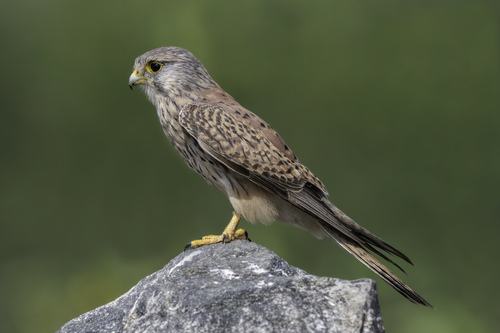
Common Kestrel
The Common Kestrel (Falco tinnunculus) is a bird of prey widely recognized for its distinctive hovering flight while hunting. It plays a crucial ecological role as a predator of small mammals, particularly voles, helping to regulate rodent populations. This adaptable species is found across a vast range, encompassing Europe, Asia, and Africa, and has even colonized some oceanic islands. While not typically considered a bird of significant cultural importance, its presence is often associated with open landscapes and agricultural areas, making it a familiar sight to many.
32-39 cm
Length
68-82 cm
Wingspan
Least Concern
Conservation Status
Distribution
The Common Kestrel has one of the largest geographic ranges of any bird of prey. It is found throughout Europe, Asia, and Africa, extending from the northernmost parts of Scandinavia and Siberia to South Africa. It is also present on many Atlantic and Pacific islands. Migratory populations exist, with northern birds often moving south for the winter.
Lifespan
The average lifespan in the wild is around 2-4 years, although some individuals can live much longer. In captivity, they can live up to 15-20 years.
Common Kestrel's Habitat
Habitat Types
Grasslands, Heathlands, Agricultural fields, Open woodlands, Urban areas, Coastal cliffs
Climate Zones
Temperate, Tropical, Subtropical, Boreal
Adaptations
Kestrels are highly adaptable to various habitats. Their hunting style, which involves hovering and scanning the ground, is particularly effective in open areas. They can also utilize man-made structures like buildings and pylons for nesting and perching.
Variations
Numerous subspecies of the Common Kestrel are recognized, differing slightly in size, plumage coloration, and geographic distribution. For example, *Falco tinnunculus rupicolaeformis* is a subspecies found in parts of Africa.
Appearance
Breeding Plumage
There is little difference between breeding and non-breeding plumage, although breeding plumage may be slightly brighter.
Seasonal Feather Changes
Minimal seasonal variation; plumage may become slightly worn and faded over time.
Sex Based Plumage Differences
Males have a grey head and tail, with a rufous back and upperwings with black spots. Females have a brown head and tail, with brown upperparts and more extensive barring.
Notable Features
Pointed wings typical of falcons., Long tail, often fanned when hovering., Dark 'tear-mark' below the eye., Sharp talons for catching prey.
Diet and Feeding
Primary Foods
Small mammals (especially voles), Insects (e.g., beetles, grasshoppers), Small birds, Lizards (in some regions)
Foraging Behavior
The Common Kestrel is famous for its hunting technique of hovering in the air, facing into the wind, while scanning the ground for prey. It also hunts from perches, such as fence posts or trees. Once prey is spotted, it dives quickly to capture it.
Specializations
Kestrels have excellent eyesight, allowing them to spot small prey from a considerable height. They are also able to see ultraviolet light, which helps them detect the urine trails of voles, leading them to areas with high prey density.
Seasonal Diet Variations
Diet can vary seasonally depending on prey availability. In winter, when voles may be less active, kestrels may consume more insects or birds.
Behavior
Social Structure
Generally solitary or found in pairs, except during migration or at communal roosts in winter.
Communication
A sharp 'kee-kee-kee' call is common., Visual displays, such as head-bobbing and tail-fanning.
Migration
Many populations are migratory, particularly those in northern regions. They may travel long distances to wintering grounds in Africa or southern Asia. The specific routes and timing vary depending on the population.
Territorial or Group Behaviors
Kestrels are territorial during the breeding season, defending their nesting site and surrounding hunting area from other kestrels. Outside of the breeding season, they may be more tolerant of other individuals.
Conservation
Threats
Habitat loss (due to agricultural intensification and urbanization), Pesticide use (reducing prey availability and causing secondary poisoning), Collision with vehicles and power lines, Climate change (affecting prey distribution and breeding success)
Protection Programs
Habitat restoration and management projects., Monitoring of pesticide levels in prey species., Legal protection in many countries.
Local National Laws
Protected under various national and international laws, such as the EU Birds Directive.
Population Trend
Stable
Population Estimates
The global population is estimated to be in the millions, although some regional populations have experienced declines.
Interesting Facts
Kestrels can see ultraviolet light.
This allows them to detect the urine trails of voles, which reflect UV light, making it easier to find their prey.
They are one of the most widespread birds of prey.
Their adaptability to different habitats and climates has allowed them to colonize a vast range across the globe.
Kestrels don't build nests
Kestrels are cavity nesters and will use old nests, cliffs and man-made structures.
Faqs about Common Kestrel
What is the main food of the Common Kestrel?
The main food is small mammals, particularly voles, although they also eat insects, birds, and lizards.
How can I tell the difference between a male and female kestrel?
Males have a grey head and tail, while females have a brown head and tail with more barring.
Are Common Kestrels endangered?
No, they are classified as Least Concern by the IUCN, meaning they are not currently considered to be at risk of extinction.
Do Kestrels migrate?
Populations in the northern hemisphere migrate south for the winter.
Copyright @ Nature Style Limited. All Rights Reserved.
 English
English